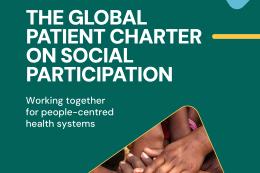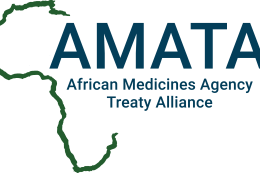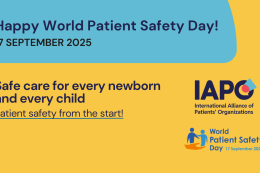World Health Organization's 10 facts on patient safety

The global need for patient safety is a topic that Patient Solidarity Day 2018 seeks to bring to the attention of health stakeholders globally as it is a serious global public health concern.
IAPO’s Declaration on patient-centred healthcare states that every patient must have access to safe, appropriate, and quality assured services and treatments. If the principle of patient safety is not properly guaranteed in health policy and practice, no healthcare system can be said truly patient centric. On this note, WHO published some facts showing that significant numbers of patients are harmed during health care, either resulting in permanent injury, increased length of stay in health care facilities, or even death. Please see this information summarised in the form of a patient safety fact file.
Fact 1: Patient harm is the 14th leading cause of the global disease burden, comparable to diseases such as tuberculosis and malariaIt is estimated that there are 421 million hospitalizations in the world annually, and approximately 42.7 million adverse events occur in patients during these hospitalizations. Using conservative estimates the latest data shows that patient harm is the 14th leading cause of morbidity and mortality across the world.
Fact 2: While in hospital, 1 in every 10 patients is harmedEstimates show that in high income countries as many as 1 in 10 patients is harmed while receiving hospital care. The harm can be caused by a range of incidents or adverse events, with nearly 50% of them being preventable.
In a study on frequency and preventability of adverse events across 26 low and middle-income countries (LMICs), the rate of adverse events was around 8%, of which 83% could have been prevented and 30% lead to death. Approximately two- thirds of all adverse events occur in LMICs.
Fact 3: Unsafe use of medication harms millions and costs billions of dollars annuallyUnsafe medication practices and medication errors are a leading cause of avoidable harm in health care systems across the world. Globally, the cost associated with medication errors has been estimated at US$ 42 billion annually, not counting lost wages, productivity, or health care costs. This amounts to almost 1% of global expenditure on health.
Medication errors occur when weak medication systems and/or human factors such as fatigue of personnel, poor working conditions, work flow interruptions or staff shortages affect prescribing, dispensing, administration and monitoring practices, which can then result in severe harm, disability and even death.
Fact 4: 15% of health spending is wasted dealing with all aspects of adverse eventsRecent evidence shows that 15% of total hospital activity and expenditure in OECD (Organisation of Economic Cooperation and Development) countries is a direct result of adverse events, with the most burdensome events including venous thromboembolism, pressure ulcers and infections. It is estimated that the aggregate cost of harm in these countries alone amounts to trillions of US dollars every year.
Fact 5: Investments in reducing patient safety incidents can lead to significant financial savingsInvestment in reducing patient safety incidents can lead to significant financial savings, not to mention better patient outcomes.
In the United States alone, focused safety improvements led to an estimated US$ 28 billion in savings in Medicare hospitals between 2010 and 2015.
Fact 6: Hospitals infections affect 14 out of every 100 patients admittedOf every 100 hospitalised patients at any given time, 7 in high-income countries and 10 in low and middle income countries, will acquire health care-associated infections (HAIs), affecting hundreds of millions of patients worldwide each year. Each year around 3.2 million patients are infected with HAIs across the European Union and a total of 37 000 of them die as a direct consequence.
Simple and low cost infection prevention and control measures, such as appropriate hand hygiene, could reduce the frequency of HAIs by more than 50%.
Fact 7: More than one million patients die annually from surgical complicationsFindings by WHO suggest that surgery still results in high rates of morbidity and mortality globally, with at least 7 million people a year experiencing disabling surgical complications, from which more than 1 million die. Although perioperative and anaesthetic-related mortality rates have progressively declined over the last 50 years, partially as a result of efforts to improve patient safety in the perioperative setting, they still remain two to three times higher in low and middle-income countries than in high income countries.
Fact 8: Inaccurate or delayed diagnoses affect all settings of care and harm an unacceptable number of patientsResearch shows that at least 5% of adults in the United States experience a diagnostic error each year in outpatient settings. Recent postmortem examination research spanning decades has shown that diagnostic errors contribute to approximately 10% of patient deaths in the United States of America. In Malaysia, a cross-sectional study in primary care clinics ascertained a prevalence of diagnostic errors at 3.6%.
Medical record reviews also suggest that diagnostic errors account for 6 to 17% of all adverse events in hospitals.
Evidence from low- and middle-income countries is limited; however, the expected rate is higher than in high-income countries as the diagnosis process is further impacted by factors, such as limited access to care and diagnostic testing resources, insufficient qualified primary care providers and specialists and paper-based record systems.
Fact 9: While the use of radiation has improved health care, overall medical exposure to radiation is a public health and safety concernThe medical use of ionizing radiation is the largest single contributor to population exposure to radiation from artificial sources. Worldwide, there are over 3.6 billion x-ray examinations performed every year, with around 10% of them occurring in children. Additionally, there are over 37 million nuclear medicine and 7.5 million radiotherapy procedures conducted annually. Inappropriate or unskilled use of medical radiation can lead to health hazards both for patients and health care professionals.
Fact 10: Administrative errors account for up to half of all medical errors in primary careRecent literature reviews have revealed that medical errors in primary care occur between 5 and 80 times per 100 000 consultations.
Administrative errors - those associated with the systems and processes of delivering care - are the most frequently reported type of errors in primary care. It is estimated that from 5 to 50% of all medical errors in primary care are administrative errors.



